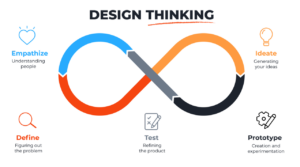This case study explores the integration of design thinking principles within the framework of flipped learning. Design thinking, a user-centered approach to problem-solving, is applied here to enhance the effectiveness and engagement of flipped learning methodologies in educational settings.

Reframe the problem
The overarching goal is to optimize the learning experience by addressing common challenges in traditional educational methods. Flipped learning, which reverses the traditional classroom model by delivering instructional content online outside of class and using class time for active learning, offers a promising framework.
However, effective implementation often requires addressing diverse learning styles, ensuring content relevance, and fostering interactive engagement.
Explain your approach
- Empathize: The process begins with empathizing with learners and educators to understand their needs, motivations, and challenges within the context of flipped learning. This phase involves techniques such as interviews, observations, and surveys to gather insights.
- Define the Problem: Based on empathy findings, defining the problem involves synthesizing collected data to identify specific pain points and opportunities for improvement. This step sets the foundation for focusing efforts on areas that can have the most significant impact on learning outcomes.
- Ideate: Ideation encourages creative thinking to generate a wide range of potential solutions to the defined problems. Brainstorming sessions and ideation workshops are used to explore different concepts and approaches that could enhance the flipped learning experience.
- Prototype: Prototyping involves translating selected ideas from the ideation phase into tangible representations. These prototypes can range from low-fidelity sketches to more interactive simulations or mock-ups, depending on the complexity and stage of development.
- Test: Testing prototypes involves gathering feedback from stakeholders, including learners and educators, to evaluate usability, effectiveness, and user satisfaction. Iterative testing allows for the refinement and validation of solutions based on real-world insights.

Findings
In applying design thinking to flipped learning, several critical challenges have been identified:
- Personalization deficiency: Traditional instructional methods often adopt a one-size-fits-all approach, neglecting the diverse learning styles and paces of students. This lack of personalization can hinder engagement and fail to optimize individual learning outcomes.
- Engagement issues: During the online content consumption phase, students often exhibit passive learning behaviors, which can lead to decreased motivation and retention. This passive approach contrasts with the active learning encouraged during in-class activities in flipped learning models.
- Relevance and alignment: There’s a significant gap between independently acquired knowledge through online content and the practical application or reinforcement of that knowledge in classroom settings. This discrepancy undermines the coherence and effectiveness of both learning environments.
Methodology and analytical tools
The methodology employed qualitative research methods such as interviews and surveys with educators and students. These methods helped in understanding current pain points and preferences within the flipped learning environment. Analytical tools included thematic analysis to categorize and prioritize issues based on frequency and impact.
Discussion
Key challenges addressed by Design Thinking in Flipped Learning
Design thinking provides a systematic framework to tackle these challenges:
- Empathetic understanding: By empathizing with both learners and educators, design thinking helps uncover nuanced insights into their needs, preferences, and challenges within flipped learning environments. This understanding is crucial for designing solutions that resonate with users and enhance their learning experiences.
- Focused problem definition: Design thinking emphasizes defining problems based on synthesized data from empathy exercises. This process ensures that efforts are concentrated on addressing the most impactful pain points, such as personalization, engagement, and alignment of content.
- Creative ideation and prototyping: Ideation sessions foster diverse thinking to generate innovative solutions tailored to identified problems. Prototyping then allows for the translation of these ideas into tangible forms, facilitating iterative testing and refinement based on real-world feedback.
Proposed solutions
To further innovate digital learning experiences within flipped learning contexts:
- Enhanced personalization: Implement adaptive learning technologies that dynamically adjust content delivery based on individual learning styles and progress. This approach ensures that each student receives tailored support, fostering deeper engagement and understanding.
- Interactive content design: Develop multimedia modules that promote active participation through features like simulations, quizzes, and collaborative activities. These interactive elements not only enhance engagement but also facilitate deeper comprehension and retention of knowledge.
- Integration of real-world applications: Incorporate real-life case studies and simulations that connect theoretical learning to practical applications. By contextualizing knowledge, this approach prepares students for real-world challenges and reinforces the relevance of classroom learning.
Evaluation and implementation considerations
While these solutions offer significant benefits, challenges such as initial costs, technological requirements, and faculty training must be carefully addressed. Successful integration hinges on thorough planning, continuous evaluation, and adaptation to ensure sustained impact within educational institutions.
Conclusion
Integrating design thinking with flipped learning offers a structured approach to innovation in educational practices. By focusing on user needs, defining clear objectives, ideating creative solutions, prototyping concepts, and testing iteratively, educators can tailor learning experiences that are more engaging, effective, and responsive to diverse learner needs.
Moving forward, continued application of design thinking principles can further evolve flipped learning methodologies, driving continuous improvement and adaptation to meet evolving educational challenges and opportunities.
This theoretical framework demonstrates how design thinking can serve as a powerful tool to enrich educational practices, fostering a learner-centric approach that aligns with the dynamic nature of modern learning environments.
Your feedback and suggestions on this case study are welcome! How would you further innovate digital learning experiences?
References
- E-book “No Bullshit Guide to UX” By Michal Malewicz. Link (SquarePlanet Academy).
- DigiComPass. “Flipped Learning.” DigiComPass. Link (DigiComPass).
- Pashler, H., McDaniel, M., Rohrer, D., & Bjork, R. (2008). Learning styles: Concepts and evidence. Psychological Science in the Public Interest, 9(3), 105-119.
- Prince, M. (2004). Does active learning work? A review of the research. Journal of Engineering Education, 93(3), 223-231.
